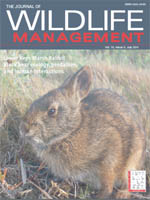The increase of double-crested cormorant (Phalacrocorax auritus; hereafter, cormorant) populations during the last 2 decades has impacted many stakeholder groups. The negative effects of nesting cormorants on trees and other vegetation have motivated private organizations and government agencies to manage nesting colonies and reduce their impacts to private property and public resources. Management-induced reproductive failure has been shown to influence cormorant inter-annual nesting colony fidelity, but not complete abandonment from a nesting colony site. We attached very high frequency (VHF) transmitters and Global Positioning System (GPS) transmitters to nesting cormorants to monitor their movement response on a managed site (Young Island, VT [YI]) and an unmanaged site (Four Brothers Islands, NY [FB]). Additionally, we monitored these sites to determine the influence of management activities on subsequent-year colonization. On YI, management consisted of egg-oiling all cormorant nests (some nests had been oiled in previous years) and culling approximately 20% of adults. Annual dispersal rates did not differ between managed and unmanaged sites, but a nesting period interaction occurred with greater dispersal on the managed site following the incubation period. After 4 years of both egg oiling and culling, cormorant nesting on YI declined to zero. Simultaneously, cormorant numbers increased on the nearby unmanaged FB. We propose either the cumulative effect of partial or complete reproductive failure (8 yr) or simply the inclusion of adult culling (4 yr) caused the abandonment. From a colony-specific management perspective, the rapid decline was beneficial to the goal of restoring the vegetative community on YI. The effects of adult culling at nesting colonies, prior-year reproductive failure caused by egg oiling, or the combination of these factors may be required for complete and rapid nesting site abandonment. The use of culling adult breeders reduced nesting and likely limits the cost and logistics of control and allows more rapid initiation of mitigation measures and island habitat restoration.
How to translate text using browser tools
1 June 2011
Effects of Management on Double-Crested Cormorant Nesting Colony Fidelity
Bronson K. Strickland,
Brian S. Dorr,
Fred Pogmore,
Gary Nohrenberg,
Scott C. Barras,
John E. McConnell,
John Gobeille
ACCESS THE FULL ARTICLE
It is not available for individual sale.
This article is only available to subscribers.
It is not available for individual sale.
It is not available for individual sale.

Journal of Wildlife Management
Vol. 75 • No. 5
July 2011
Vol. 75 • No. 5
July 2011
colony abandonment
Culling
dispersal
Double-crested Cormorant
egg oiling
nesting colony fidelity
New York




